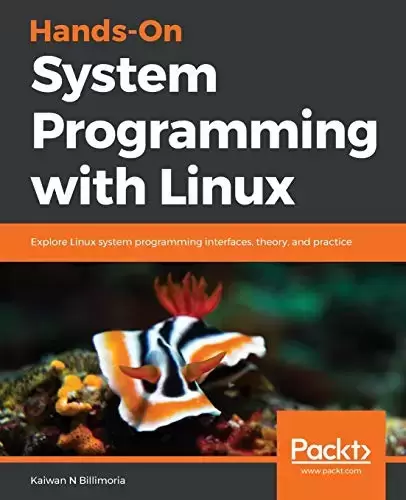
Book Description
Get up and running with system programming concepts in Linux
Key Features
- Acquire insight on Linux system architecture and its programming interfaces
- Get to grips with core concepts such as process management, signalling and pthreads
- Packed with industry best practices and dozens of code examples
Book Description
The Linux OS and its embedded and server applications are critical components of today’s software infrastructure in a decentralized, networked universe. The industry’s demand for proficient Linux developers is only rising with time. Hands-On System Programming with Linux gives you a solid theoretical base and practical industry-relevant descriptions, and covers the Linux system programming domain. It delves into the art and science of Linux application programming― system architecture, process memory and management, signaling, timers, pthreads, and file IO.
This book goes beyond the use API X to do Y approach; it explains the concepts and theories required to understand programming interfaces and design decisions, the tradeoffs made by experienced developers when using them, and the rationale behind them. Troubleshooting tips and techniques are included in the concluding chapter.
By the end of this book, you will have gained essential conceptual design knowledge and hands-on experience working with Linux system programming interfaces.
What you will learn
- Explore the theoretical underpinnings of Linux system architecture
- Understand why modern OSes use virtual memory and dynamic memory APIs
- Get to grips with dynamic memory issues and effectively debug them
- Learn key concepts and powerful system APIs related to process management
- Effectively perform file IO and use signaling and timers
- Deeply understand multithreading concepts, pthreads APIs, synchronization and scheduling
Who this book is for
Hands-On System Programming with Linux is for Linux system engineers, programmers, or anyone who wants to go beyond using an API set to understanding the theoretical underpinnings and concepts behind powerful Linux system programming APIs. To get the most out of this book, you should be familiar with Linux at the user-level logging in, using shell via the command line interface, the ability to use tools such as find, grep, and sort. Working knowledge of the C programming language is required. No prior experience with Linux systems programming is assumed.
Table of Contents
- Linux System Architecture
- Virtual Memory
- Resource Limits
- Dynamic Memory Allocation
- Linux Memory Issues
- Debugging Tools for Common Memory Issues
- Process Credentials
- Process Execution
- Process Capabilities
- Process Creation
- Signalling – Part 1
- Signalling – Part 2
- Timers
- Multithreading with Pthreads Part 1-Essentials
- Multithreading with Pthreads Part II – Synchronization
- Multithreading with Pthreads Part III
- CPU Scheduling on Linux
- Advanced File I/O
- Troubleshooting and Best Practices
- File IO Essentials
- Daemon Processes
中文:
书名:Linux系统编程实践:探索Linux系统编程接口、理论和实践
熟悉Linux中的系统编程概念
主要特点
- 深入了解Linux系统架构及其编程接口
- 掌握核心概念,如进程管理、信令和p线程
- 充斥着行业最佳实践和数十个代码示例
图书描述
在分散的网络世界中,Linux操作系统及其嵌入式和服务器应用程序是当今软件基础设施的关键组件。该行业对熟练的Linux开发人员的需求只会与时俱进。使用Linux的实践系统编程为您提供了坚实的理论基础和与行业相关的实用描述,涵盖了Linux系统编程领域。它深入研究了Linux应用程序编程的艺术和科学–系统架构、进程内存和管理、信令、计时器、p线程和文件IO。
这本书超越了Use API X to Do Y方法;它解释了理解编程接口和设计决策所需的概念和理论,有经验的开发人员在使用它们时所做的权衡,以及它们背后的基本原理。故障排除提示和技术包含在最后一章中。
在本书结束时,您将获得基本的概念设计知识和使用Linux系统编程接口的实践经验。
你将学到什么
- Explore the theoretical underpinnings of Linux system architecture
- 了解现代操作系统为何使用虚拟内存和动态内存API
- 掌握动态内存问题并对其进行有效调试
- 了解与流程管理相关的关键概念和强大的系统API
- 有效执行文件IO并使用信令和计时器
- 深入了解多线程概念、pThressAPI、同步和调度
Who this book is for
Linux系统编程实践是为Linux系统工程师、程序员或任何想要超越使用API集来理解强大的Linux系统编程API背后的理论基础和概念的人而编写的。要充分利用这本书,您应该熟悉Linux在用户级别的登录、通过命令行界面使用Shell以及使用诸如Find、grep和Sort等工具的能力。必须具备C编程语言的应用知识。假设您没有Linux系统编程的经验。
目录表
- Linux系统架构
- Virtual Memory
- 资源限制
- 动态内存分配
- Linux内存问题
- 针对常见内存问题的调试工具
- 进程凭据
- 流程执行
- 流程能力
- 流程创建
- 信令(第1部分)
- 信令(第二部分)
- 定时器
- 使用P线程进行多线程处理第1部分-要领
- 多线程技术第二部分:同步
- 用多线程实现多线程技术第三部分
- Linux环境下的CPU调度
- Advanced File I/O
- 故障排除和最佳实践
- 文件IO基本要素
- 守护进程
评论前必须登录!
注册